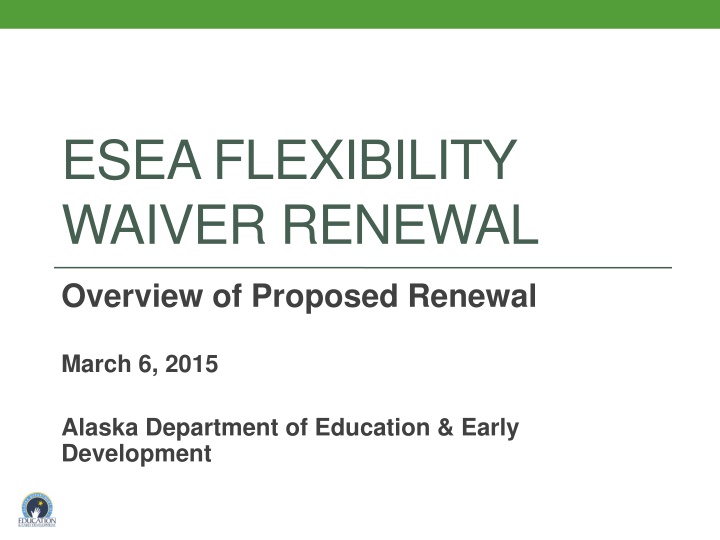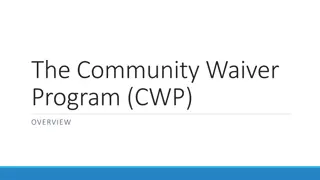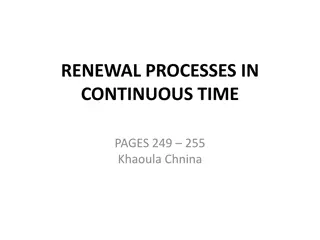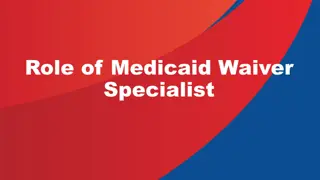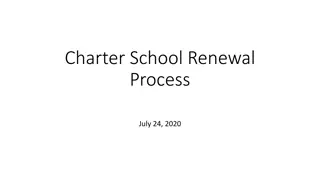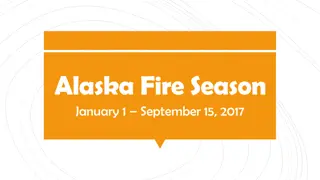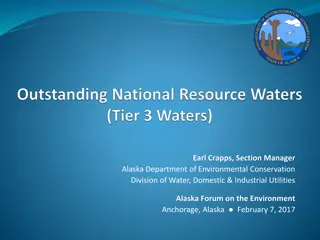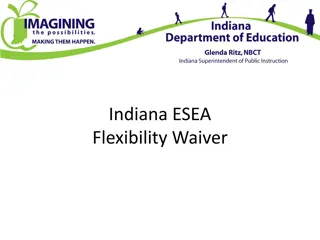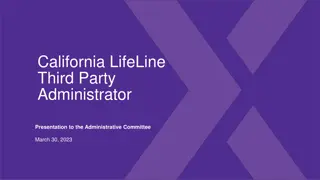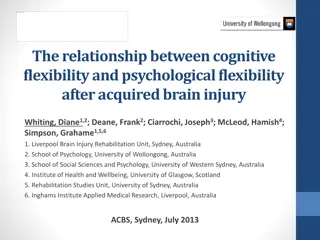Alaska ESEA Flexibility Waiver Renewal Overview
Alaska Department of Education & Early Development is proposing a renewal for the ESEA Flexibility Waiver, focusing on key principles such as college and career-ready expectations for all students, state-developed differentiated accountability, and support for effective instruction and leadership. The renewal aims to maintain a state accountability system, provide resources for low-performing schools, and avoid reverting to the all-or-nothing AYP system. The proposal includes specifics on standards, assessments, accountability systems, and support mechanisms for schools and districts.
Download Presentation

Please find below an Image/Link to download the presentation.
The content on the website is provided AS IS for your information and personal use only. It may not be sold, licensed, or shared on other websites without obtaining consent from the author.If you encounter any issues during the download, it is possible that the publisher has removed the file from their server.
You are allowed to download the files provided on this website for personal or commercial use, subject to the condition that they are used lawfully. All files are the property of their respective owners.
The content on the website is provided AS IS for your information and personal use only. It may not be sold, licensed, or shared on other websites without obtaining consent from the author.
E N D
Presentation Transcript
ESEA FLEXIBILITY WAIVER RENEWAL Overview of Proposed Renewal March 6, 2015 Alaska Department of Education & Early Development
2 3 Key Principles for Waivers 1. College- and Career-Ready Expectations for All Students 2. State-Developed Differentiated Recognition, Accountability, and Support 3. Supporting Effective Instruction and Leadership
3 Why Apply for a Waiver Renewal? To maintain one state accountability system based on the Alaska School Performance Index. To provide focused state resources on lowest-performing schools. To refrain from returning to the all or nothing system for meeting Adequate Yearly Progress (AYP), which did not recognize school or student growth or progress.
4 Principle 1: College- and Career-Ready Expectations for All Students Requirements for waiver: Alaska adopted college- and career-ready (CCR) standards in English/language arts and mathematics in June 2012. Alaska is administering high-quality assessments that measure student growth starting in 2015. English Language Proficiency (ELP) standards and assessments are in place. No changes are proposed for Principle 1 in renewal of waiver.
5 Principle 2 - Accountability & Support Requirements for waiver: Accountability system for all schools Provide a state-developed differentiated accountability system for all schools to improve student achievement and school performance, close achievement gaps, and increase the quality of instruction for all students. AMO targets Set ambitious but achievable Annual Measurable Object (AMO) targets for the percentage of students proficient in English/Language Arts and Math; report for all students and all No Child Left Behind (NCLB) subgroups annually.
6 Principle 2 Support for Schools and Districts Requirements for waiver: Identify and recognize reward schools. Identify and provide support to priority and focus schools. Provide incentives and supports for all Title I schools. Build state, district, and school capacity to improve student learning in all schools.
7 Principle 2 Waiver Renewal Plans Accountability system for all schools (ASPI) Schools will maintain the same Alaska School Performance Index (ASPI) score and star rating for 2015-2016 as the school had for 2014-2015 (based on the 2014 assessments). AMO Targets 2015 assessment data will be used as a new baseline year for AMO targets. AMO targets will be reset through 2019-2020 with the goal of reducing by half the percentage of students not meeting the standards within six years for the all students group and each subgroup.
8 Principle 2 Waiver Renewal Plans Support for Schools and Districts Priority and focus schools will retain that classification for the 2015- 2016 school year and will be expected to continue implementation of the interventions. No new reward schools will be identified for 2015-2016 based on 2015 data. All other schools will continue with the school improvement plans for 2015-2016 as required by the ASPI star rating and criteria for required plans as were in place for the 2014-2015 school year. Districts will retain their 2014-2015 tier designation based on the number and percentage of 1- and 2-star schools from 2014 assessments and will continue to receive the same support from EED during the 2015-2016 school year as they had in 2014-2015.
9 Principle 2 After Renewal Conduct standard-setting process to determine cut scores and levels of achievement for AMP assessments July 7-10. Submit proposed regulations for new cut scores, achievement levels, and AMO targets to State Board of Education (SBOE) late July 2015 for public comment. SBOE considers adoption in September 2015. If adopted, EED issues student AMP results and reports October 2015.
10 Principle 2 Amendment Timeline EED considers revisions to accountability system based on new assessments (fall 2015) Academic achievement and growth components of ASPI AMO targets Any other changes to accountability and support system that may be needed Receive stakeholder feedback fall 2015 Propose regulation changes required for revised sections of accountability system (December 2015) Submit waiver Principle 2 amendment to (U.S. Department of Education (US ED) by January, 2016 SBOE adopt regulations and US ED approves amendment spring 2016
11 Principle 3 Supporting Effective Instruction and Leadership Requirements for ESEA Waiver Principle 3: Develop and adopt state guidelines for local teacher and principal evaluation and support systems. Ensure districts implement teacher and principal evaluation and support systems that are consistent with state guidelines. Support teacher and principal effectiveness beyond the current highly qualified teacher requirements.
12 Principle 3 - Guidelines for Teacher and Principal Evaluation Systems The teacher and principal evaluation systems must: be used for continual improvement of instruction; differentiate performance with at least three levels; include as a significant factor data on student learning growth for all students (including English Learners and students with disabilities), and other measures of professional practice; evaluate teachers and principals on a regular basis; provide clear, timely, and useful feedback, including feedback that identifies needs and guides professional development; and be used to inform personnel decisions.
13 Principle 3 Current AK Provisions Use of nationally-recognized evaluation framework aligned to Alaska professional content and performance standards District adopted by end of 2014-2015 Four performance levels exemplary, proficient, basic, or unsatisfactory Report aggregate data at each overall level to EED for 2015-2016 Plan of professional growth or plan of improvement required for unsatisfactory or basic levels of performance Level of support depends on criteria Unsatisfactory on one or more standard requires Plan of Improvement Proficient or higher leads to Professional Learning focus educator rated proficient or higher on at least seven standards with no unsatisfactory ratings
14 Principle 3 Student Learning Data Current Alaska regulations include using data on student learning growth for all students as a significant factor in educator evaluations beginning in 2015-2016 Use two to four measures of student growth to determine administrators and teachers contributions to student learning. Use statewide assessments as one of the measures of student learning for teachers of tested subjects and grade when appropriate statewide assessments are available. Assign one of four performance levels exemplary, proficient, basic, or unsatisfactory to the student learning data standard. Student learning data included at 20% for 2015-2016, increasing to 35% in 2017-2018, and increasing to 50% in 2018-2019 and beyond.
15 Principle 3 Waiver Renewal Plans Postpone inclusion of student learning data for one year In 2015-2016, overall rating will be based on the district's chosen observation system (e.g. Danielson, Marzano). Overall ratings reported in aggregate to EED In 2015-2016, districts must pilot the incorporation of at least one measure of non-AMP student learning data per teacher and principal. Regulation changes associated with these proposals will be presented to the State Board of Education (SBOE) in March 2015. At this meeting the SBOE will vote to put the regulations out for public comment.
16 Principle 3 Student Learning Data Changes In 2016-2017, incorporate student learning data ELA and Math educators will receive a rating based on AMP and 1- 3 additional measures of student learning growth non-ELA and -Math educators will receive a rating based on 2-4 measures of student learning growth Remove the 20/35/50 percentages based on student learning data when determining an educator's overall rating. Substitute the current overall rating rule with a rule that prohibits a teacher or principal from receiving an overall rating of proficient or exemplary if the rating for the student learning data is unsatisfactory. Determination of level of support will not change
17 ESEA Flexibility Waiver Timeline Submit proposed regulations to SBOE March 20, 2015, for public comment. Submit waiver renewal request by March 31, 2015, with a pause in the accountability system and changes to the Educator Evaluation timeline and overall rating determination. Administer 2015 AMP assessments March 30-May 1. June, 2015 SBOE votes on adopting proposed regulations US ED approves Alaska s waiver renewal request
18 Comments on Waiver Renewal Submit comments and feedback by March 25 on Alaska s waiver proposal through the online feedback form. Link under News & Announcements on EED s home page: http://education.alaska.gov/Surveys/Esea/FlexibilityWaiverComments See information about Alaska s proposal for the waiver on the ESEA Flexibility Waiver page. A draft copy will be posted by mid-March. http://education.alaska.gov/akaccountability/ (green ESEA Waiver tab) Participate in webinars/audio conferences to learn about the waiver proposal. See schedule on the ESEA Flexibility Waiver page.
19 Questions? Principle 2 Accountability & Support Margaret MacKinnon, Director of Assessment & Accountability margaret.mackinnon@alaska.gov 907-465-2970 Principle 3 Educator Evaluation Systems Sondra Meredith, Administrator, Teacher Education & Certification sondra.Meredith@alaska.gov 907-465-8663
